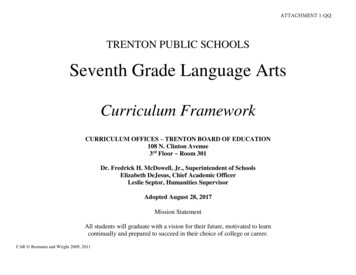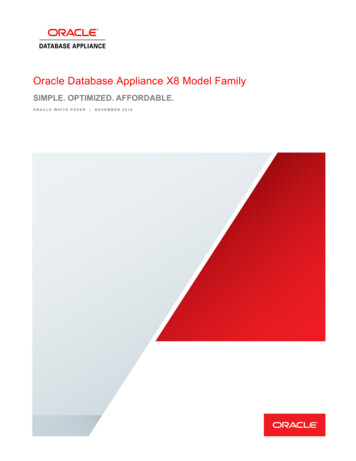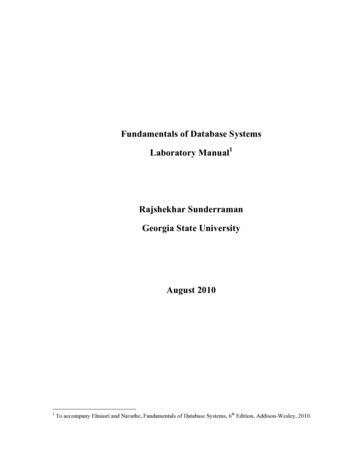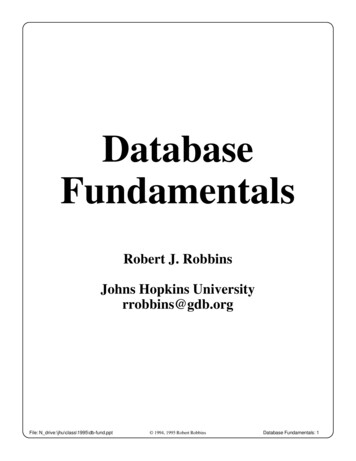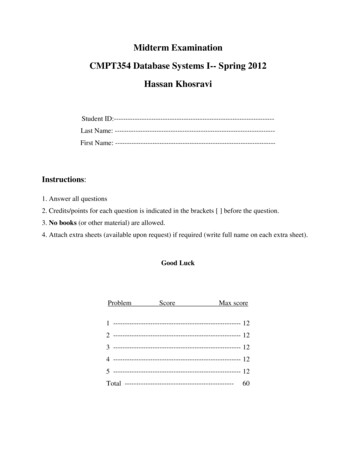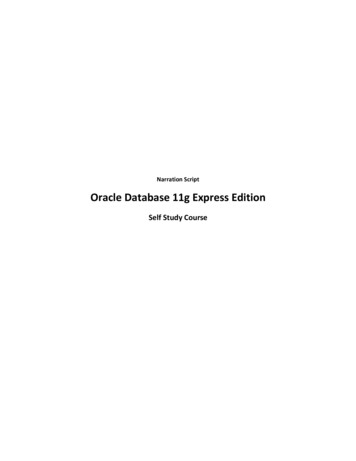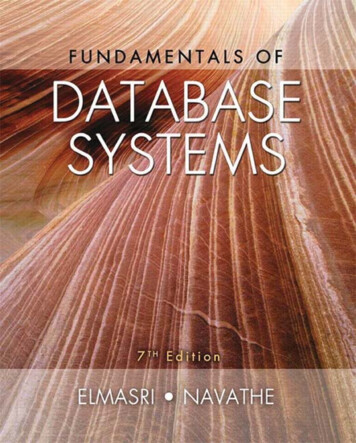
Transcription
FUNDAMENTALS OFDatabaseSystemsSEVENTH EDITION
This page intentionally left blank
FUNDAMENTALS OFDatabaseSystemsSEVENTH EDITIONRamez ElmasriDepartment of Computer Science and EngineeringThe University of Texas at ArlingtonShamkant B. NavatheCollege of ComputingGeorgia Institute of TechnologyBoston Columbus Indianapolis New York San Francisco HobokenAmsterdam Cape Town Dubai London Madrid Milan Munich Paris Montreal TorontoDelhi Mexico City São Paulo Sydney Hong Kong Seoul Singapore Taipei Tokyo
Vice President and Editorial Director, ECS:Marcia J. HortonAcquisitions Editor: Matt GoldsteinEditorial Assistant: Kelsey LoanesMarketing Managers: Bram Van Kempen, Demetrius HallMarketing Assistant: Jon BryantSenior Managing Editor: Scott DisannoProduction Project Manager: Rose KernanProgram Manager: Carole SnyderGlobal HE Director of Vendor Sourcingand Procurement: Diane HynesDirector of Operations: Nick SklitsisOperations Specialist: Maura Zaldivar-GarciaCover Designer: Black Horse DesignsManager, Rights and Permissions: Rachel YoudelmanAssociate Project Manager, Rights and Permissions:Timothy NichollsFull-Service Project Management: Rashmi Tickyani,iEnergizer Aptara , Ltd.Composition: iEnergizer Aptara , Ltd.Printer/Binder: Edwards Brothers MalloyCover Printer: Phoenix Color/HagerstownCover Image: Micha Pawlitzki/Terra/CorbisTypeface: 10.5/12 Minion ProCopyright 2016, 2011, 2007 by Ramez Elmasri and Shamkant B. Navathe. All rights reserved. Manufacturedin the United States of America. This publication is protected by Copyright and permissions should be obtainedfrom the publisher prior to any prohibited reproduction, storage in a retrieval system, or transmission in anyform or by any means, electronic, mechanical, photocopying, recording, or likewise. To obtain permission(s) touse materials from this work, please submit a written request to Pearson Higher Education, PermissionsDepartment, 221 River Street, Hoboken, NJ 07030.Many of the designations by manufacturers and seller to distinguish their products are claimed as trademarks.Where those designations appear in this book, and the publisher was aware of a trademark claim, the designationshave been printed in initial caps or all caps.The author and publisher of this book have used their best efforts in preparing this book. These efforts includethe development, research, and testing of theories and programs to determine their effectiveness. The author andpublisher make no warranty of any kind, expressed or implied, with regard to these programs or thedocumentation contained in this book. The author and publisher shall not be liable in any event for incidental orconsequential damages with, or arising out of, the furnishing, performance, or use of these programs.Microsoft and/or its respective suppliers make no representations about the suitability of the informationcontained in the documents and related graphics published as part of the services for any purpose. All suchdocuments and related graphics are provided “as is” without warranty of any kind. Microsoft and/or its respectivesuppliers hereby disclaim all warranties and conditions with regard to this information, including all warrantiesand conditions of merchantability. Whether express, implied or statutory, fitness for a particular purpose, titleand non-infringement. In no event shall microsoft and/or its respective suppliers be liable for any special,indirect or consequential damages or any damages whatsoever resulting from loss of use, data or profits, whetherin an action of contract. Negligence or other tortious action, arising out of or in connection with the use orperformance of information available from the services.The documents and related graphics contained herein could include technical inaccuracies or typographicalerrors. Changes are periodically added to the information herein. Microsoft and/or its respective suppliers maymake improvements and/or changes in the product(s) and/or the program(s) described herein at any time.Partial screen shots may be viewed in full within the software version specified.Library of Congress Cataloging-in-Publication Data on File10 9 8 7 6 5 4 3 2 1ISBN-10:0-13-397077-9ISBN-13: 978-0-13-397077-7
To Amaliaandto Ramy, Riyad, Katrina, and ThomasR. E.To my wife Aruna for her love, support, and understandingandto Rohan, Maya, and Ayush for bringing so much joy into our livesS.B.N.
This page intentionally left blank
PrefaceThis book introduces the fundamental conceptsnecessary for designing, using, and implementingdatabase systems and database applications. Our presentation stresses the fundamentals of database modeling and design, the languages and models provided by thedatabase management systems, and database system implementation techniques.The book is meant to be used as a textbook for a one- or two-semester course indatabase systems at the junior, senior, or graduate level, and as a reference book. Ourgoal is to provide an in-depth and up-to-date presentation of the most importantaspects of database systems and applications, and related technologies. We assumethat readers are familiar with elementary programming and data-structuring concepts and that they have had some exposure to the basics of computer organization.New to This EditionThe following key features have been added in the seventh edition: A reorganization of the chapter ordering (this was based on a survey of theinstructors who use the textbook); however, the book is still organized sothat the individual instructor can choose to follow the new chapter orderingor choose a different ordering of chapters (for example, follow the chapterorder from the sixth edition) when presenting the materials.There are two new chapters on recent advances in database systems and bigdata processing; one new chapter (Chapter 24) covers an introduction to thenewer class of database systems known as NOSQL databases, and the othernew chapter (Chapter 25) covers technologies for processing big data,including MapReduce and Hadoop.The chapter on query processing and optimization has been expanded andreorganized into two chapters; Chapter 18 focuses on strategies and algorithms for query processing whereas Chapter 19 focuses on query optimization techniques.A second UNIVERSITY database example has been added to the early chapters (Chapters 3 through 8) in addition to our COMPANY database examplefrom the previous editions.Many of the individual chapters have been updated to varying degrees to includenewer techniques and methods; rather than discuss these enhancements here,vii
viiiPrefacewe will describe them later in the preface when we discuss the organization ofthe seventh edition.The following are key features of the book: A self-contained, flexible organization that can be tailored to individualneeds; in particular, the chapters can be used in different orders dependingon the instructor’s preference.A companion website des data to be loaded into various types of relational databases for morerealistic student laboratory exercises.A dependency chart (shown later in this preface) to show which chaptersdepend on other earlier chapters; this can guide the instructor who wants totailor the order of presentation of the chapters.A collection of supplements, including a robust set of materials for instructors and students such as PowerPoint slides, figures from the text, and aninstructor’s guide with solutions.Organization and Contents of the Seventh EditionThere are some organizational changes in the seventh edition as well as improvement to the individual chapters. The book is now divided into 12 parts as follows: Part 1 (Chapters 1 and 2) describes the basic introductory concepts necessary for a good understanding of database models, systems, and languages.Chapters 1 and 2 introduce databases, typical users, and DBMS concepts,terminology, and architecture, as well as a discussion of the progression ofdatabase technologies over time and a brief history of data models. Thesechapters have been updated to introduce some of the newer technologiessuch as NOSQL systems. Part 2 (Chapters 3 and 4) includes the presentation on entity-relationshipmodeling and database design; however, it is important to note that instructors can cover the relational model chapters (Chapters 5 through 8) beforeChapters 3 and 4 if that is their preferred order of presenting the coursematerials. In Chapter 3, the concepts of the Entity-Relationship (ER) modeland ER diagrams are presented and used to illustrate conceptual databasedesign. Chapter 4 shows how the basic ER model can be extended to incorporate additional modeling concepts such as subclasses, specialization, generalization, union types (categories) and inheritance, leading to theenhanced-ER (EER) data model and EER diagrams. The notation for the classdiagrams of UML are also introduced in Chapters 7 and 8 as an alternativemodel and diagrammatic notation for ER/EER diagrams. Part 3 (Chapters 5 through 8) includes a detailed presentation on relationaldatabases and SQL with some additional new material in the SQL chaptersto cover a few SQL constructs that were not in the previous edition. Chapter 5
Prefacedescribes the basic relational model, its integrity constraints, and updateoperations. Chapter 6 describes some of the basic parts of the SQL standardfor relational databases, including data definition, data modification operations, and simple SQL queries. Chapter 7 presents more complex SQL queries, as well as the SQL concepts of triggers, assertions, views, and schemamodification. Chapter 8 describes the formal operations of the relationalalgebra and introduces the relational calculus. The material on SQL (Chapters 6 and 7) is presented before our presentation on relational algebra andcalculus in Chapter 8 to allow instructors to start SQL projects early in acourse if they wish (it is possible to cover Chapter 8 before Chapters 6 and 7if the instructor desires this order). The final chapter in Part 2, Chapter 9,covers ER- and EER-to-relational mapping, which are algorithms that can beused for designing a relational database schema from a conceptual ER/EERschema design. Part 4 (Chapters 10 and 11) are the chapters on database programming techniques; these chapters can be assigned as reading materials and augmentedwith materials on the particular language used in the course for programming projects (much of this documentation is readily available on the Web).Chapter 10 covers traditional SQL programming topics, such as embeddedSQL, dynamic SQL, ODBC, SQLJ, JDBC, and SQL/CLI. Chapter 11 introducesWeb database programming, using the PHP scripting language in our examples, and includes new material that discusses Java technologies for Webdatabase programming. Part 5 (Chapters 12 and 13) covers the updated material on object-relationaland object-oriented databases (Chapter 12) and XML (Chapter 13); both ofthese chapters now include a presentation of how the SQL standard incorporates object concepts and XML concepts into more recent versions of theSQL standard. Chapter 12 first introduces the concepts for object databases,and then shows how they have been incorporated into the SQL standard inorder to add object capabilities to relational database systems. It then coversthe ODMG object model standard, and its object definition and query languages. Chapter 13 covers the XML (eXtensible Markup Language) modeland languages, and discusses how XML is related to database systems. Itpresents XML concepts and languages, and compares the XML model totraditional database models. We also show how data can be convertedbetween the XML and relational representations, and the SQL commandsfor extracting XML documents from relational tables. Part 6 (Chapters 14 and 15) are the normalization and relational designtheory chapters (we moved all the formal aspects of normalization algorithms to Chapter 15). Chapter 14 defines functional dependencies, andthe normal forms that are based on functional dependencies. Chapter 14also develops a step-by-step intuitive normalization approach, and includesthe definitions of multivalued dependencies and join dependencies.Chapter 15 covers normalization theory, and the formalisms, theories,ix
xPreface and algorithms developed for relational database design by normalization, including the relational decomposition algorithms and the relationalsynthesis algorithms.Part 7 (Chapters 16 and 17) contains the chapters on file organizations ondisk (Chapter 16) and indexing of database files (Chapter 17). Chapter 16describes primary methods of organizing files of records on disk, includingordered (sorted), unordered (heap), and hashed files; both static anddynamic hashing techniques for disk files are covered. Chapter 16 has beenupdated to include materials on buffer management strategies for DBMSs aswell as an overview of new storage devices and standards for files and modern storage architectures. Chapter 17 describes indexing techniques for files,including B-tree and B -tree data structures and grid files, and has beenupdated with new examples and an enhanced discussion on indexing,including how to choose appropriate indexes and index creation duringphysical design. Part 8 (Chapters 18 and 19) includes the chapters on query processing algorithms (Chapter 18) and optimization techniques (Chapter 19); these twochapters have been updated and reorganized from the single chapter thatcovered both topics in the previous editions and include some of the newertechniques that are used in commercial DBMSs. Chapter 18 presents algorithms for searching for records on disk files, and for joining records fromtwo files (tables), as well as for other relational operations. Chapter 18 contains new material, including a discussion of the semi-join and anti-joinoperations with examples of how they are used in query processing, as wellas a discussion of techniques for selectivity estimation. Chapter 19 coverstechniques for query optimization using cost estimation and heuristic rules;it includes new material on nested subquery optimization, use of histograms,physical optimization, and join ordering methods and optimization oftypical queries in data warehouses. Part 9 (Chapters 20, 21, and 22) covers transaction processing concepts;concurrency control; and database recovery from failures. These chaptershave been updated to include some of the newer techniques that are usedin some commercial and open source DBMSs. Chapter 20 introduces thetechniques needed for transaction processing systems, and defines theconcepts of recoverability and serializability of schedules; it has a new section on buffer replacement policies for DBMSs and a new discussion onthe concept of snapshot isolation. Chapter 21 gives an overview of the various types of concurrency control protocols, with a focus on two-phaselocking. We also discuss timestamp ordering and optimistic concurrencycontrol techniques, as well as multiple-granularity locking. Chapter 21includes a new presentation of concurrency control methods that are basedon the snapshot isolation concept. Finally, Chapter 23 focuses on databaserecovery protocols, and gives an overview of the concepts and techniquesthat are used in recovery.
Preface Part 10 (Chapters 23, 24, and 25) includes the chapter on distributed databases (Chapter 23), plus the two new chapters on NOSQL storage systemsfor big data (Chapter 24) and big data technologies based on Hadoop andMapReduce (Chapter 25). Chapter 23 introduces distributed databaseconcepts, including availability and scalability, replication and fragmentation of data, maintaining data consistency among replicas, and many otherconcepts and techniques. In Chapter 24, NOSQL systems are categorizedinto four general categories with an example system in each category usedfor our examples, and the data models, operations, as well as the replication/distribution/scalability strategies of each type of NOSQL system arediscussed and compared. In Chapter 25, the MapReduce programmingmodel for distributed processing of big data is introduced, and then wehave presentations of the Hadoop system and HDFS (Hadoop DistributedFile System), as well as the Pig and Hive high-level interfaces, and theYARN architecture.Part 11 (Chapters 26 through 29) is entitled Advanced Database Models,Systems, and Applications and includes the following materials: Chapter 26introduces several advanced data models including active databases/triggers (Section 26.1), temporal databases (Section 26.2), spatial databases (Section 26.3), multimedia databases (Section 26.4), and deductivedatabases (Section 26.5). Chapter 27 discusses information retrieval (IR)and Web search, and includes topics such as IR and keyword-based search,comparing DB with IR, retrieval models, search evaluation, and rankingalgorithms. Chapter 28 is an introduction to data mining including overviews of various data mining methods such as associate rule mining, clustering, classification, and sequential pattern discovery. Chapter 29 is anoverview of data warehousing including topics such as data warehousingmodels and operations, and the process of building a data warehouse.Part 12 (Chapter 30) includes one chapter on database security, whichincludes a discussion of SQL commands for discretionary access control(GRANT, REVOKE), as well as mandatory security levels and models forincluding mandatory access control in relational databases, and a discussionof threats such as SQL injection attacks, as well as other techniques andmethods related to data security and privacy.Appendix A gives a number of alternative diagrammatic notations for displaying aconceptual ER or EER schema. These may be substituted for the notation we use, ifthe instructor prefers. Appendix B gives some important physical parameters ofdisks. Appendix C gives an overview of the QBE graphical query language, andAppendixes D and E (available on the book’s Companion Website located athttp://www.pearsonhighered.com/elmasri) cover legacy database systems, based onthe hierarchical and network database models. They have been used for more thanthirty years as a basis for many commercial database applications and transactionprocessing systems.xi
xiiPrefaceGuidelines for Using This BookThere are many different ways to teach a database course. The chapters in Parts 1through 7 can be used in an introductory course on database systems in the orderthat they are given or in the preferred order of individual instructors. Selected chapters and sections may be left out and the instructor can add other chapters from therest of the book, depending on the emphasis of the course. At the end of the opening section of some of the book’s chapters, we list sections that are candidates forbeing left out whenever a less-detailed discussion of the topic is desired. We suggestcovering up to Chapter 15 in an introductory database course and including selectedparts of other chapters, depending on the background of the students and thedesired coverage. For an emphasis on system implementation techniques, chaptersfrom Parts 7, 8, and 9 should replace some of the earlier chapters.Chapters 3 and 4, which cover conceptual modeling using the ER and EER models,are important for a good conceptual understanding of databases. However, theymay be partially covered, covered later in a course, or even left out if the emphasisis on DBMS implementation. Chapters 16 and 17 on file organizations and indexingmay also be covered early, later, or even left out if the emphasis is on database models and languages. For students who have completed a course on file organization,parts of these chapters can be assigned as reading material or some exercises can beassigned as a review for these concepts.If the emphasis of a course is on database design, then the instructor should coverChapters 3 and 4 early on, followed by the presentation of relational databases. Atotal life-cycle database design and implementation project would cover conceptualdesign (Chapters 3 and 4), relational databases (Chapters 5, 6, and 7), data modelmapping (Chapter 9), normalization (Chapter 14), and application programsimplementation with SQL (Chapter 10). Chapter 11 also should be covered if theemphasis is on Web database programming and applications. Additional documentation on the specific programming languages and RDBMS used would be required.The book is written so that it is possible to cover topics in various sequences. Thefollowing chapter dependency chart shows the major dependencies among chapters. As the diagram illustrates, it is possible to start with several different topicsfollowing the first two introductory chapters. Although the chart may seem complex, it is important to note that if the chapters are covered in order, the dependencies are not lost. The chart can be consulted by instructors wishing to use analternative order of presentation.For a one-semester course based on this book, selected chapters can be assigned asreading material. The book also can be used for a two-semester course sequence.The first course, Introduction to Database Design and Database Systems, at thesophomore, junior, or senior level, can cover most of Chapters 1 through 15. Thesecond course, Database Models and Implementation Techniques, at the senior orfirst-year graduate level, can cover most of Chapters 16 through 30. The twosemester sequence can also be designed in various other ways, depending on thepreferences of the instructors.
Prefacexiii1, 2Introductory5RelationalModel3, 4ER, EERModels6, 7SQL8RelationalAlgebra16, 17File Organization,Indexing9ER-, EER-toRelational20, 21, 22Transactions,CC, Recovery14, 15FD, MVD,Normalization23, 24, 25DDB, NOSQL,Big Data12, 13ODB, ORDB,XML10, 11DB, WebProgramming26, 27AdvancedModels, IR28, 29Data Mining,Warehousing18, 19Query Processing,OptimizationSupplemental MaterialsSupport material is available to qualified instructors at Pearson’s instructorresource center (http://www.pearsonhighered.com/irc). For access, contact yourlocal Pearson representative. PowerPoint lecture notes and figures.A solutions manual.AcknowledgmentsIt is a great pleasure to acknowledge the assistance and contributions of many individuals to this effort. First, we would like to thank our editor, Matt Goldstein, forhis guidance, encouragement, and support. We would like to acknowledge theexcellent work of Rose Kernan for production management, Patricia Daly for a30DBSecurity
xivPrefacethorough copy editing of the book, Martha McMaster for her diligence in proofingthe pages, and Scott Disanno, Managing Editor of the production team. We alsowish to thank Kelsey Loanes from Pearson for her continued help with the project,and reviewers Michael Doherty, Deborah Dunn, Imad Rahal, Karen Davis, GillieanLee, Leo Mark, Monisha Pulimood, Hassan Reza, Susan Vrbsky, Li Da Xu, WeiningZhang and Vincent Oria.Ramez Elmasri would like to thank Kulsawasd Jitkajornwanich, Vivek Sharma, andSurya Swaminathan for their help with preparing some of the material in Chapter 24. Sham Navathe would like to acknowledge the following individuals whohelped in critically reviewing and revising various topics. Dan Forsythe and SatishDamle for discussion of storage systems; Rafi Ahmed for detailed re-organizationof the material on query processing and optimization; Harish Butani, BalajiPalanisamy, and Prajakta Kalmegh for their help with the Hadoop and MapReducetechnology material; Vic Ghorpadey and Nenad Jukic for revision of the DataWarehousing material; and finally, Frank Rietta for newer techniques in databasesecurity, Kunal Malhotra for various discussions, and Saurav Sahay for advances ininformation retrieval systems.We would like to repeat our thanks to those who have reviewed and contributed toprevious editions of Fundamentals of Database Systems. First edition. Alan Apt (editor), Don Batory, Scott Downing, DennisHeimbinger, Julia Hodges, Yannis Ioannidis, Jim Larson, Per-Ake Larson,Dennis McLeod, Rahul Patel, Nicholas Roussopoulos, David Stemple,Michael Stonebraker, Frank Tompa, and Kyu-Young Whang.Second edition. Dan Joraanstad (editor), Rafi Ahmed, Antonio Albano, DavidBeech, Jose Blakeley, Panos Chrysanthis, Suzanne Dietrich, Vic Ghorpadey,Goetz Graefe, Eric Hanson, Junguk L. Kim, Roger King, Vram Kouramajian,Vijay Kumar, John Lowther, Sanjay Manchanda, Toshimi Minoura, InderpalMumick, Ed Omiecinski, Girish Pathak, Raghu Ramakrishnan, Ed Robertson,Eugene Sheng, David Stotts, Marianne Winslett, and Stan Zdonick.Third edition. Maite Suarez-Rivas and Katherine Harutunian (editors);Suzanne Dietrich, Ed Omiecinski, Rafi Ahmed, Francois Bancilhon, JoseBlakeley, Rick Cattell, Ann Chervenak, David W. Embley, Henry A. Etlinger,Leonidas Fegaras, Dan Forsyth, Farshad Fotouhi, Michael Franklin, SreejithGopinath, Goetz Craefe, Richard Hull, Sushil Jajodia, Ramesh K. Karne,Harish Kotbagi, Vijay Kumar, Tarcisio Lima, Ramon A. Mata-Toledo, JackMcCaw, Dennis McLeod, Rokia Missaoui, Magdi Morsi, M. Narayanaswamy,Carlos Ordonez, Joan Peckham, Betty Salzberg, Ming-Chien Shan, JunpingSun, Rajshekhar Sunderraman, Aravindan Veerasamy, and Emilia E. Villareal.Fourth edition. Maite Suarez-Rivas, Katherine Harutunian, Daniel Rausch,and Juliet Silveri (editors); Phil Bernhard, Zhengxin Chen, Jan Chomicki,Hakan Ferhatosmanoglu, Len Fisk, William Hankley, Ali R. Hurson, VijayKumar, Peretz Shoval, Jason T. L. Wang (reviewers); Ed Omiecinski (whocontributed to Chapter 27). Contributors from the University of Texas at
Preface Arlington are Jack Fu, Hyoil Han, Babak Hojabri, Charley Li, Ande Swathi,and Steven Wu; Contributors from Georgia Tech are Weimin Feng, Dan Forsythe, Angshuman Guin, Abrar Ul-Haque, Bin Liu, Ying Liu, Wanxia Xie,and Waigen Yee.Fifth edition. Matt Goldstein and Katherine Harutunian (editors); MichelleBrown, Gillian Hall, Patty Mahtani, Maite Suarez-Rivas, Bethany Tidd, andJoyce Cosentino Wells (from Addison-Wesley); Hani Abu-Salem, Jamal R.Alsabbagh, Ramzi Bualuan, Soon Chung, Sumali Conlon, Hasan Davulcu,James Geller, Le Gruenwald, Latifur Khan, Herman Lam, Byung S. Lee,Donald Sanderson, Jamil Saquer, Costas Tsatsoulis, and Jack C. Wileden(reviewers); Raj Sunderraman (who contributed the laboratory projects);Salman Azar (who contributed some new exercises); Gaurav Bhatia, Fariborz Farahmand, Ying Liu, Ed Omiecinski, Nalini Polavarapu, Liora Sahar,Saurav Sahay, and Wanxia Xie (from Georgia Tech).Sixth edition. Matt Goldstein (editor); Gillian Hall (production management); Rebecca Greenberg (copy editing); Jeff Holcomb, Marilyn Lloyd,Margaret Waples, and Chelsea Bell (from Pearson); Rafi Ahmed, VenuDasigi, Neha Deodhar, Fariborz Farahmand, Hariprasad Kumar, Leo Mark,Ed Omiecinski, Balaji Palanisamy, Nalini Polavarapu, Parimala R. Pranesh,Bharath Rengarajan, Liora Sahar, Saurav Sahay, Narsi Srinivasan, andWanxia Xie.Last, but not least, we gratefully acknowledge the support, encouragement, andpatience of our families.R. E.S.B.N.xv
This page intentionally left blank
ContentsPrefaceviiAbout the Authorsxxx1 partIntroduction to Databases chapter 1 Databases and Database Users31.1 Introduction41.2 An Example61.3 Characteristics of the Database Approach101.4 Actors on the Scene151.5 Workers behind the Scene171.6 Advantages of Using the DBMS Approach171.7 A Brief History of Database Applications231.8 When Not to Use a DBMS271.9 Summary27Review Questions28Exercises28Selected Bibliography29chapter 2 Database System Conceptsand Architecture312.1 Data Models, Schemas, and Instances322.2 Three-Schema Architecture and Data Independence362.3 Database Languages and Interfaces382.4 The Database System Environment422.5 Centralized and Client/Server Architectures for DBMSs462.6 Classification of Database Management Systems512.7 Summary54Review Questions55Exercises55Selected Bibliography56xvii
xviiiContents2 partConceptual Data Modeling and Database Design chapter 3 Data Modeling Using the Entity–Relationship (ER)Model593.1 Using High-Level Conceptual Data Modelsfor Database Design603.2 A Sample Database Application623.3 Entity Types, Entity Sets, Attributes, and Keys633.4 Relationship Types, Relationship Sets, Roles, and StructuralConstraints723.5 Weak Entity Types793.6 Refining the ER Design for the COMPANY Database803.7 ER Diagrams, Naming Conventions, and Design Issues813.8 Example of Other Notation: UML Class Diagrams853.9 Relationship Types of Degree Higher than Two883.10 Another Example: A UNIVERSITY Database923.11 Summary94Review Questions96Exercises96Laboratory Exercises103Selected Bibliography104chapter 4 The Enhanced Entity–Relationship (EER)Model1074.1 Subclasses, Superclasses, and Inheritance1084.2 Specialization and Generalization1104.3 Constraints and Characteristics of Specialization and GeneralizationHierarchies1134.4 Modeling of UNION Types Using Categories1204.5 A Sample UNIVERSITY EER Schema, Design Choices, and FormalDefinitions1224.6 Example of Other Notation: Representing Specialization andGeneralization in UML Class Diagrams1274.7 Data Abstraction, Knowledge Representation, and OntologyConcepts1284.8 Summary135Review Questions135Exercises136Laboratory Exercises143Selected Bibliography146
Contents3 partThe Relational Data Model and SQL chapter 5 The Relational Data Model and RelationalDatabase Constraints1495.1 Relational Model Concepts1505.2 Relational Model Constraints and Relational Database Schemas5.3 Update Operations, Transactions, and Dealing with ConstraintViolations1655.4 Summary169Review Questions170Exercises170Selected Bibliography175chapter 6 Basic SQL1571776.1 SQL Data Definition and Data Types1796.2 Specifying Constraints in SQL1846.3 Basic Retrieval Queries in SQL1876.4 INSERT, DELETE, and UPDATE Statements in SQL6.5 Additional Features of SQL2016.6 Summary202Review Questions203Exercises203Selecte
mentals of database modeling and design, the languages and models provided by the database management systems, and database system implementation techniques. The book is meant to be used as a textbook for a one- or two-semester course in database systems at the junior




